Our lab has studied regeneration abilities using the planarian species Schmidtea mediterranea and the acoel Hofstenia miamia to investigate fundamental aspects of regeneration. The vignettes below describe of several recent and ongoing projects.
Whole-body regeneration in the planarian Schmidtea mediterranea

The planarian Schmidtea mediterranea has been a major focus of our study. Planarians can regenerate an entirely new body in just a week, using pluripotent adult stem cells termed neoblasts that produce all tissue lineages. Neoblasts either directly or indirectly receive instructions from regionalized factors expressed in body-wall muscle in order to produce differentiated tissues in correct location and abundance. Planarians can be grown in large numbers, facilitating high-throughput screens for identification of genes required for various steps in the process of regeneration. Tools such as whole-mount histology, single-cell RNAseq, systemic RNAi and tissue/cell transplantation have enabled detailed study of the developmental mechanisms of whole-body regeneration in this system. In addition, planarians have been regeneration model systems for over a century, so there is a wealth of information from prior work that facilitates their study today.
Regeneration Patterning

How do regenerating animals “know” what is missing after they are injured? The mechanism of regeneration must enable highly robust control of tissue information. We have identified a suite of RNAi phenotypes in which aspects of body pattern through regeneration are disrupted. Factors driving pattern formation regulate a set of genes expressed in standing gradients from planarian muscle to build a rough map of positional information used to build the body. These systems interface with injury signaling and each other in order to drive the upstream regeneration process. Our studies seek to understand how adult positional information can be robustly encoded and restored after injury.
Symmetry breaking and the onset of regeneration

What decisions are made at the very onset of regeneration? We identified RNAi phenotypes by inhibition of factors in which blastema identity is inverted to produce 2-headed or 2-tailed animals. The identified factors encode key regulators of the Wnt signaling pathway, the ligand wnt1 and secreted inhibitor notum. Both genes are injury-induced in muscle cells, and wnt1 is generically induced at any injury site while notum is activated selectively at anterior-facing wound sites. Even a slice injury that does not remove tissue elicits notum expression asymmetrically, suggesting that an early critical property in regeneration decisions is the ability for tissue to compute its orientation with respect to a wound site. What processes break symmetry to drive regeneration? Our work has identified a noncanonical Wnt signaling pathway controlled by Wnt11 family factors acting through Disheveled in order to orient notum responsiveness following injury. The mechanisms relating tissue polarization to injury will be important to understand the decision processes in outgrowth.
Brain Regeneration and cell number control

Despite their simple body plan, planarians have a relatively complex brain, which can fully regenerate after head amputation. This makes planarians a promising model organism for studying adult neurogenesis. In addition, whole-body regeneration capability across animals appears to be linked to the ability to reversibly control animal size through cell number regulation. We have used cell enumeration assays to understand the mechanisms of proportion restoration through regeneration and also as phenotypic readouts in high throughput screens to identify factors involved in tissue assembly and cell number control, including identification of factors that inhibit neural regeneration.
Whole-body regeneration in the acoel Hofstenia miamia

The acoel Hofstenia miamia is another worm capable of whole-body regeneration, yet diverged from planarians distantly about 550 million years ago. Therefore, comparisons of these two systems could unravel the key conserved properties essential for whole-body regeneration abilities. Hofstenia has several experimental advantages as well, including accessibility of embryos during development, a relatively rapid lifecycle for a regenerative organism (6-8 weeks), transgenesis and CRISPR/Cas9 genetic manipulation, and a growing set of genomic resources including sequenced genome, transcriptome, ATACseq methods, and cell atlas from scRNAseq. Despite deep phylogenetic divergence, Hofstenia remarkably shares with planarians the use of Piwi+ pluripotent adult stem cells, body patterning via muscle cells, and reversible growth ability. The availability of genetic tools in this system provides an opportunity to study the cell biology of whole-body regeneration in Bilaterian aniamals. (Images above from Srivastava et al 2014, Raz et al 2017, Ricci et al 2021 and Petersen lab unpublished).
